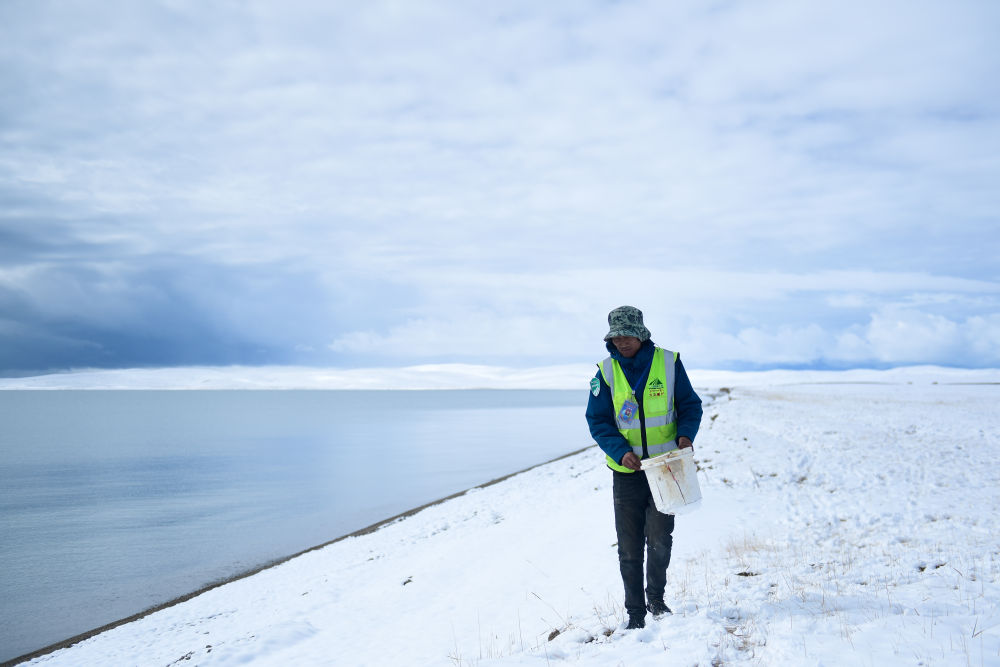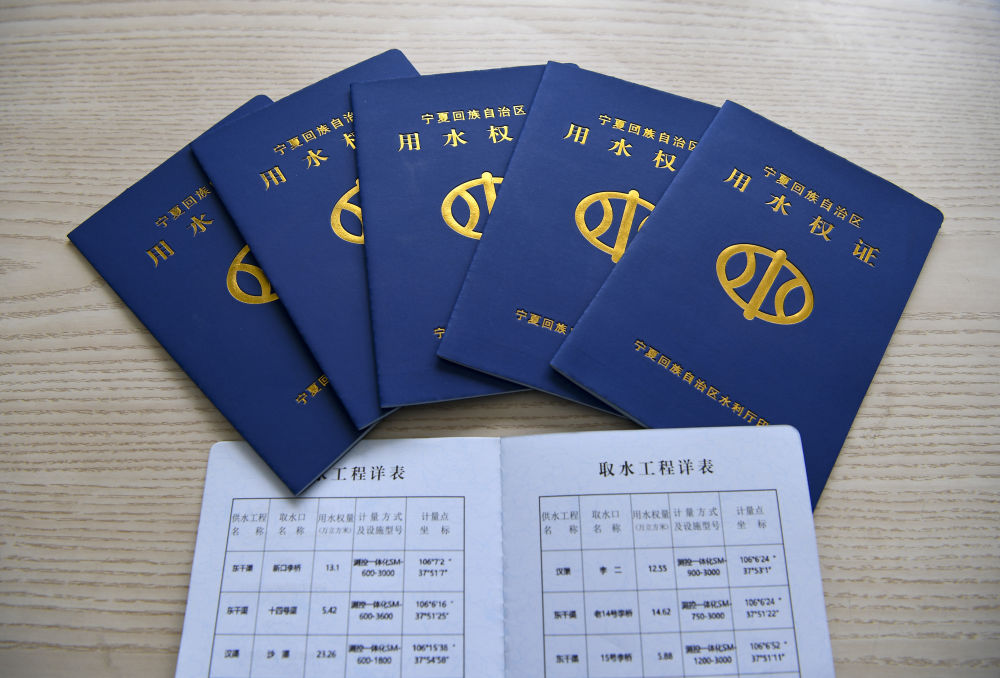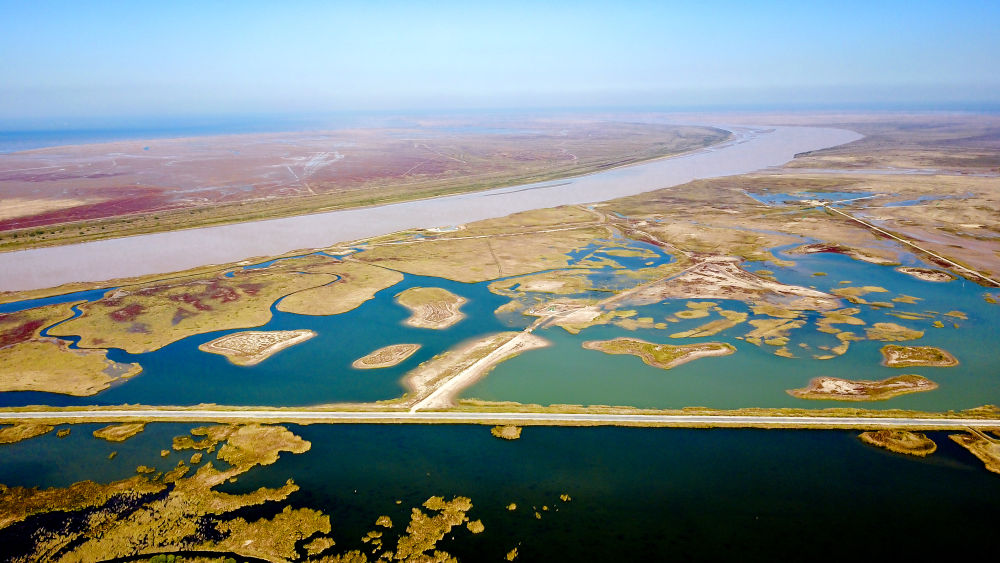Depicting a New Picture of Yellow River Ecology —— Experiences of Water Protection along the Yellow River
The Yellow River, flowing from the snow and ice in bayan har, gathers thousands of streams and rivers, crossing nine provinces and regions to nourish Chinese civilization. Under the guidance of the concept of "jointly protecting and promoting great governance", a new generation of Yellow River "water conservancy people" have made unremitting efforts to restore ecology, improve water quality and use water rationally. A picture of harmonious coexistence between man and nature is slowly unfolding along the Yellow River.
Water Ecology: Respect for Nature and Harmonious Symbiosis
In early autumn, standing in the Star Sea in maduo county, Golog Tibetan Autonomous Prefecture, Qinghai Province, countless lakes are like stars sprinkled into the earth.
Early in the morning, Tongde, an ecological manager in Gadan Village, Machali Town, maduo county, took the reporter on the road to patrol the Star Sea. His family lived by grazing for generations and witnessed the change of grassland ecology. More than 20 years ago, due to long-term overgrazing, Maduo became devastated from a land rich in water and grass, and the income of herders decreased.
In recent years, maduo county has implemented the policy of "fixing livestock by grass", scientifically and rationally utilized grasslands, and explored the development path of modern ecological grassland animal husbandry. Like many herders, Tongde put down his whip, and now his job is to pick up garbage, patrol lakes and grasslands and protect wild animals.

On October 20, 2021, in Lena Village, Zhalinghu Township, maduo county, Golog Tibetan Autonomous Prefecture, Qinghai Province, the ecological manager of the Yellow River Source Park of Sanjiangyuan National Park picked up garbage by Zhalinghu Lake. Xinhua News Agency reporter Zhang Long photo
The Yellow River descends from Maduo on the Qinghai-Tibet Plateau and meets Fenhe on the Loess Plateau.
Wanrong section of Fenhe River in Shanxi Province is the last pass where Fenhe River flows into the Yellow River. "People often say that the Yellow River is only 48 poles wide, and both sides can hear it." Pan Xinjie, former director of the office of Wanrong Yellow River Affairs Bureau, said that it is said that Xuanyuan Huangdi once swept the floor on the bank of the Yellow River as an altar to worship the afterlife. Today, the site of the sweeping altar is located in the Houtu Temple. Historically, the Houtu Temple has been destroyed by floods three times and moved twice.

This is a photo taken in Wanrong County, Yuncheng City, Shanxi Province overlooking the Yellow River and Fenhe River. (UAV shooting) (Photo courtesy of the interviewee)
Fenhe River is the second largest tributary of the Yellow River, which has an important impact on the ecological security of the middle and lower reaches of the Yellow River. Nowadays, walking in the Wanrong section of Fenhe River, we can see that there are holes in the coastal slopes, and the holes are full of Amorpha fruticosa.
"More than 4 million such holes have been pierced on the left bank of the Fenhe River in Wanrong." Xie Xiaobin, a staff member of Wanrong County Water Conservancy Bureau, said that Amorpha fruticosa has the functions of protecting dike sand, preventing wind and fixing sand, and is a "living steel bar" for dam protection. More than 4 million Amorpha fruticosa roots on the shore to build a beautiful ecological barrier for the Wanrong section of Fenhe River.
The Yellow River falls to the East China Sea, and Wan Li writes in his mind.
From the mouth of the Yellow River in Dongying, Shandong Province, all the way upstream, Liang Jinhui, a researcher of the ecological investigation project team of key rivers and lakes in Shandong Province, and his colleagues sampled along the Yellow River. Water, sediment and epiphytic algae of the Yellow River … … Samples were carefully collected into the container.
Liang Jinhui introduced that after the later detection and analysis of the samples, the sampling at 40 points on the bank of the Yellow River will generate a "physical examination report" containing 85 indicators, providing first-hand information for dynamically recording the alternation and evolution of aquatic organisms in the Yellow River.
In the game of ecological protection, the ecological environment in the upper, middle and lower reaches of the Yellow River has its own characteristics, and each can exert its ecological linkage control effect.
Water Environment: Long-term System Governance.
Shapotou district, zhongwei, Ningxia is the first stop for the Yellow River to enter Ningxia. In Fengzhuang Village, Rouyuan Town, shapotou district, there are many houses, the streets are clean and tidy, and a small river at the entrance of the village flows quietly under the bridge. "This river is the fourth drainage ditch. In the past, garbage and weeds were piled up along the ditch all the year round, and sewage was discharged directly into the ditch, which smelled bad in summer." Mai Xueping, a village cadre in feng village, said.
In recent years, Ningxia has strengthened the protection of water ecological environment, and implemented projects such as desilting and dredging of key drainage ditches into the Yellow River and construction of constructed wetlands.

The Yellow River, which flows through Qingtongxia City, Ningxia, nourishes rice and various vegetation on the shore (photo of drone, taken on May 25th). Xinhua News Agency reporter Feng Kaihua photo
In order to ensure that the water quality will not be polluted after the water system is connected, five video monitoring points, five automatic water monitoring points and five water quality monitoring points have been set up in shapotou district, and a special App has been developed to monitor the changes of water quantity and water quality online in real time.
Water environment control is not limited to rural non-point source pollution. In recent years, urban pollution control has also achieved remarkable results.
In the evening, Nanchuan River in Xining City, Qinghai Province is sparkling under the setting sun. In the urban greenway along the Nanchuan River, Jiang Xiaoyun, the river head of Xinqing Community in Nantan Sub-district Office, Chengzhong District, Xining City, opened the "Smart Water Conservancy Cloud" App and clicked "River Patrol" to start the 1.83km river patrol from Hongshui Bridge to Kunlun Bridge. "Only when I see that there is no garbage on the river and the water conservancy facilities are operating normally will my heart be practical." Jiang Xiaoyu said.

On June 3, along the Nanchuan River in Xining City, Jiang Xiaoyun, the community river chief, was patrolling the river. Xinhua News Agency reporter Li Ning photo
The Nanchuan River, now known as the "city living room", was once plagued by water pollution, silt at the bottom of the river and the wild growth of aquatic plants.
The problem is in the water, and the root is on the shore. In recent years, Xining City has improved the water quality through measures such as renovation of municipal pipe network along the river, sewage collection and treatment, improvement of river bottom, microbial purification, aquatic plant configuration, etc., and upgraded the coastal ecological environment through measures such as shoreline renovation, facility repair and beautification, and wetland ecological restoration, and the beautiful scenery of harmonious coexistence of people, birds and fish reappeared.
In recent years, under the guidance of the major national strategy of ecological protection and high-quality development in the Yellow River Basin, a series of "combination boxing" have been launched along the Yellow River. The water quality of the Yellow River basin is improving year by year, and the main stream of the Yellow River will reach Grade II water quality for the first time in 2022.
Water resources: water saving and water diversion.
Autumn is crisp. In the Qianjin Farm of Ningxia Agricultural Reclamation, tens of thousands of acres of farmland are dressed in green, showing a different "face value". After the high standard transformation of farmland and the application of intelligent irrigation technology, more than half of the water can be saved per mu here. On the exclusive trading platform, 6 million cubic meters of water saved by the farm was purchased by two water-deficient enterprises to ensure production.
The Yellow River water is like soup and steamed buns to Xia Chuan.
Ningxia, which is located in the northwest and is dry and rainy, relies heavily on the Yellow River for its development. In the past, it faced the dilemma of long-term water shortage and flood irrigation.
The utilization of water resources in Ningxia is the epitome of the Yellow River Basin, which accounts for 2% of the country’s river runoff and supports the water demand of 12% of the country’s population and 17% of its cultivated land. On the basis of a series of water right and water price reforms in recent years, since 2021, Ningxia has taken the lead in exploring the reform of water right in the provinces along the Yellow River and Nine Provinces.

Water use warrants for some villages in Gaozha Town, Litong District, Wuzhong City, Ningxia (photo taken on May 24). Xinhua News Agency reporter Feng Kaihua photo
"The confirmation of water rights is based on the red line of total amount and efficiency, which forces water users to recognize the upper limit of water use, so that suitable water planting and water production are gradually rooted in the hearts of the people." Bao Lumin, head of the special class of water right reform in Ningxia Water Resources Department, said.
Nowadays, water, as an asset, shows great value on the trading platform. Industrial enterprises and water users purchase water rights from the exclusive water market for new projects and expansion of scale.
In the past summer, the work of water and sediment regulation in the Yellow River Delta has come to an end, but the story of water, sand and people continues.
For the Yellow River Delta, water shortage is a big problem. In the past, the wetland water supply in the Yellow River Delta could only be realized by self-flowing water diversion during the water and sediment regulation period of the Yellow River.
"Every year from June 19 to July 10, there is only about 20 days." Liujing, deputy director of the Shandong Yellow River Delta National Nature Reserve Management Committee, said, "But according to years of observation, we found that the whole wetland is not the most in need of water at this stage. For example, in the spring when animals and plants grow most vigorously, the demand for water in wetlands is very strong. However, during this period, the flow of the Yellow River is small, and it is impossible to replenish water by self-flow diversion. "

This is the scenery of Shandong Yellow River Delta National Nature Reserve (drone photo) taken on October 31, 2022. Xinhua News Agency reporter Guo Xulei photo
In August last year, six sluice boats for diverting water from the Yellow River were completed in the nature reserve, and water was replenished as needed at any time according to the needs of animals and plants. The rolling Yellow River water infiltrated this vast land before it was injected into the Bohai Sea.
In recent years, the Yellow River Delta National Nature Reserve has built a scientific ecological water supply system of "diversion, transportation, storage and discharge", and at the same time, it has made great efforts to build a "river — Lu — Beach — "Sea" connectivity system, connecting the water system for 115 kilometers, dredging tidal gullies for 76 kilometers, and restoring hydrological connectivity between the Yellow River and the ocean. The original bare land and saline-alkali beach have become large wetlands with abundant aquatic plants and rich biodiversity.
Rushing from the depths of history, the Yellow River has nurtured generations of Chinese people. River soup, don’t give up day and night Today, under the guidance of the supreme leader’s ecological civilization thought, people all over the Yellow River are constantly exploring ways to protect the water of the Yellow River and striving to promote the high-quality development of the Yellow River Basin. (Reporter Shi Weiyan, Yuan Min, Zou Xinyuan, Li Ning, Chai Ting)